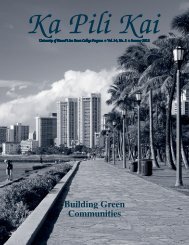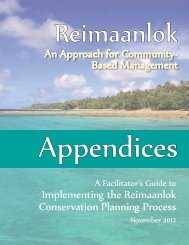2011 Environmental Product Guide - Sea Grant College Program
2011 Environmental Product Guide - Sea Grant College Program
2011 Environmental Product Guide - Sea Grant College Program
Create successful ePaper yourself
Turn your PDF publications into a flip-book with our unique Google optimized e-Paper software.
Return to Table Of Contents1.6 Executive Orders (EO)Federal Executive Orders are issued by the President of the United States regulating practices of the executivebranch, and do not affect citizens directly. Two Executive Orders are of special importance to the purchasing ofenvironmentally preferable products and operational practices of executive agencies:EO 13423, (January, 2007) - Strengthening Federal <strong>Environmental</strong>, Energy, and Transportation Management.This EO revokes several previous orders addressing the greening of governmental practices, including E.O. 13101,E.O. 13123, E.O. 13134, E.O. 13148, and E.O. 13149. The Order sets goals in the following areas: energy efficiency;acquisition; renewable energy; toxic chemical reduction; recycling; sustainable buildings; electronics stewardship;fleets; and water conservation. See http://www.fedcenter.gov/programs/eo13423/ for more information on EO13423.EO 13514, (April, 2010) - Federal Leadership in <strong>Environmental</strong>, Energy, and Economic Performance.This EO focuses on the reduction of GHG and promotion of a clean energy economy. Requirements of the EO13514 are: a) establishment of a Greenhouse Gas (GHG) Emission Reduction Target, b) development of a StrategicSustainability Performance Plan (Sustainability Plan),c) GHG Reporting and Accounting, and d) Fleet Petroleum Reduction. See http://www.fedcenter.gov/programs/eo13514/ for more information on EO 13514.Sick Building Syndrome (SBS)The Sick Building Syndrom (SBS) is a health condition where occupants ofbuildings (especially in commercial and instiutional facilities) experience irritationof the eyes, nose, throat, neurotoxic or general health problems, skin irritation,nonspecific hypersensitivity reactions, odor and taste sensations, andstress-related issues, due to poor indoor air quality. EPA identifies four maincauses or contributing factors to sick building syndrome: inadequate ventilation,chemical contaminants from indoor and outdoor sources, and biologicalcontaminants. Certain products used in building construction and O&M suchas adhesives, carpeting, upholstery, manufactured wood products, copy machines,pesticides, and cleaning agents may emit Volatile Organic Compounds(VOC’s) - including formaldehyde - that affects indoor air quality. The consequence is an increase in absenteeismrates and decrese in production, which directly affect businesses and property management, especiallyconsidering that Americans spend 90% of their time indoors 1 and the highest the cost of a building isthe cost of the people inside. Therefore, the use of low or zero emitting products, elimination of conditionsthat encourage allergenic mold growth, and a building design that decreases the chance of cross-contaminationis a necessary approach not only to achieve lower O&M costs but also to enhance public health.1U.S. EPA: Buildings and their Impact on the Environment: A Statistical Summaryhttp://www.epa.gov/greenbuilding/pubs/gbstats.pdf4
















